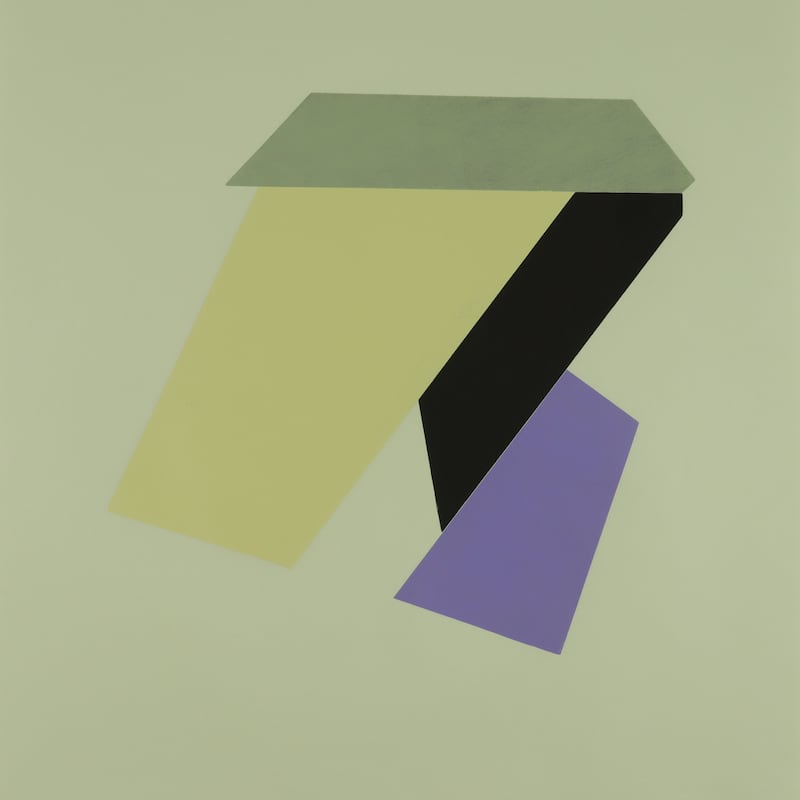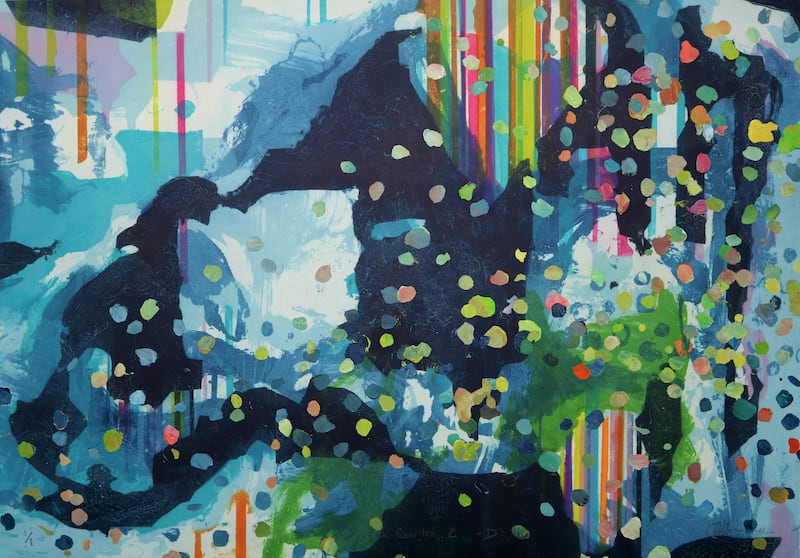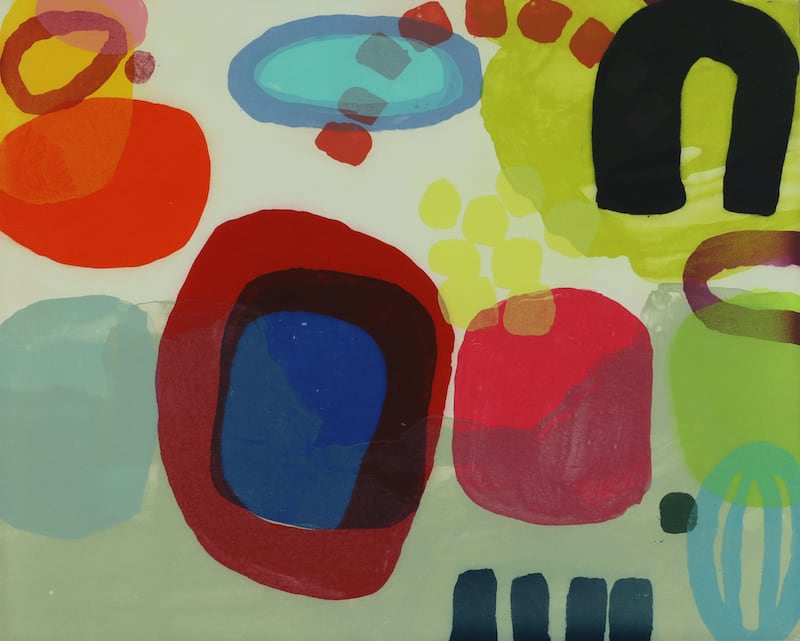On a cloudy Wednesday afternoon in London, Mark Francis has arranged his schedule to take into account drying times for his current painting, so he can pause for a bit to talk over the phone. “It’s a very systematic process, where I start and I have to finish one painting at a time. There’s a technical way of working them, and if the paint dries I can’t work them any more, so it’s quite intensive. Sometimes I have to put things in front of it, like a plastic sheet, to stop the air.”
Francis has spent some of the morning signing prints made as part of the visiting-artist programme at Graphic Studio Dublin. A fine-art printmaking scheme for invited artists, it has resulted in successful collaborations between the studio and artists including Alice Maher, Brian Maguire, Tony O’Malley, Louis le Brocquy, Anne Yeats, William Crozier, Martin Gale, Diana Copperwhite, Geraldine O’Neill and Donald Teskey over the past 43 years.
We’d be proofing the work on the plate: is the tone, the texture, okay? Let’s try this plate; let’s try this colour. And it was such a free, open, expansive way of working
Every second year there’s an exhibition. The latest features the work of Richard Gorman, Cian McLoughlin and Taffina Flood alongside that of Francis; all are abstract painters, although, as Francis says, “I sort of think of myself as an abstract painter, but a lot of people say, ‘I’m not sure if you are abstract.’” His work has its origins in science and technology, from the microcellular to the astrophysical. “I’ve gone from the microscopic, looking at diseases and blood cells, in the 1990s,” he says, to these prints, which go back to paintings he was working on in 2018 or 2019, “dealing with ideas I had about dark matter and the emptiness of space, the space in between us. Is it empty space or is there something there?
“I’ve always liked images sent back by radio telescopes,” Francis says. “Over the decades I do see patterns in my work, and one of the main things is sound.” He talks about the surface of his paintings as having aberrations: “It’s like a pulse, and then there’s an aberration in the pulse.” His 2020 solo show at the Graphic Studio Gallery was called Re-sound, and the titles of his most recent paintings point in this direction too: Sequential Pulse, Cadence, Oscillating Field, Dub Echo, Reverb Mix. “Music is very important to me, all different types of music, from classical, punk, heavy metal, techno, industrial dance, ambient, whatever it is. I have quite broad tastes.” Titles of works are often influenced by what he’s listening to in the studio. But back to the printmaking, which is an essential part of where Francis’s distinct style of painting began.
READ MORE
“In about 1989 I made a series of monoprints. I put them up in my studio and thought, How am I going to transfer these into paintings? Working on a metal plate, it was a one-off image, a way for me to explore an image and not be too precious about it.” He used a spatula to make the surface of the canvas smooth, then “I used rollers and different types of tools that I had used in the printing to try and replicate a similar type of image. So that process from the late 1980s has carried me right through to now.” There was a kind of freedom for him in starting with a print. “Printmaking is a very good medium for the accidental errors. It’s the unknown,” he says.

Niamh Flanagan, one of the master printers who works with Graphic Studio Dublin’s visiting artists, echoes the sentiment. “We worked in a really exciting way with Mark. We’d be proofing the work on the plate: is the tone, the texture, okay? Let’s try this plate; let’s try this colour. And it was such a free, open, expansive way of working. Mark was drawing with Indian ink on to drafting film. They were really beautiful, really gorgeous work. He sent over the transparencies, we made the plates, and then he came over for the proofing. He was there for a week.”
This relationship between master printer and visiting artist is one of trust, she says, and of good communication. “It’s important that it’s a safe place to fail as well. The first plate never works. If you are making a large print that is a metre by 80cm you can work on the plates on your own, but there’s going to be a team of three people printing that. That’s high pressure for an artist, especially if you look at the first print and you are, like, ‘God, I hate it.’ You’ve got three sets of eyes looking at you. It’s about coming up with solutions, and to help the artist find their voice within that.”

Flanagan fell in love with printmaking as a student at the National College of Art and Design. She joined the studio as a member in 2004, two years after graduating with first-class honours in fine-art print. “I really was surrounding myself with experts, people like Robert Russell [the current studio director, who is also working with the studio’s visiting artists], James McCreary and Stephen Lawlor. I saw how much I didn’t know, and I really saw what could be done, how professionally they were making prints, and how much I could up my game.” She started as a printer in 2009 and began working as a master printer around 2017. That shift happens “when you work independently with an artist, when you work on making the plates with the artist as opposed to just taking instruction or working alongside a master printer”, she says. And she’s passing the skills on. “At the moment I’ve got some incredibly talented printers working alongside me – Ailbhe Barrett and Michele Hetherington – and I’m training them up now to be master printmakers.”
The visiting-artist programme was started by McCreary and his fellow artist Mary Farl Powers in 1980. “What the programme did was bring in these really high-calibre artists,” says Flanagan. “Each editioned print had to be really perfect, really clean, really high-quality work. Young printmakers were being asked to make this work. It’s a source of income for the younger printers, a source of income for the gallery, there’s peer learning, collective learning, and the visiting artists are coming in and bringing their perspective. It was so pioneering in so many different ways they probably didn’t even see at the time.”

Both Francis and Flanagan agree there is a perception among buyers that print is the poor cousin of painting. “I guess it’s kind of a historic thing, the hierarchy of painting,” says Flanagan, “and the fact that it’s a multiple lessens its appeal in certain quarters. Also, I think there’s added confusion with the fact that there are plenty of artists out there reproducing paintings digitally. The word ‘print’ encompasses so many things, and that’s a problem. It encompasses everything from an Athena poster to the incredibly painstaking process of making a four-plate colour etching. When I teach a class and the student has spent six evenings making a plate, and then I tell them that’s just one plate ... I’m, like, ‘This is printmaking, baby!’”
One of the jobs of the studio is to educate audiences as well as artists. “We’re just killed here producing videos for Instagram,” Flanagan says, laughing. “I try and label it etching, photo intaglio or lithography, to steer away from the term ‘print’, as it’s so loaded with all those other things. Even limited-edition print is used to cover things that are maybe still reproductions of paintings that somebody has perhaps printed on some very nice paper with some very high-quality inks, but they haven’t gone to the trouble of producing a carborundum print that weeks of time has gone into.”

For Francis, whose paintings are in the collections of the Metropolitan Museum of Art in New York, the Tate and the Victoria and Albert Museum in London, the Ulster Museum, in Belfast, and the Irish Museum of Modern Art and the Hugh Lane in Dublin (to name a few), one of the appeals of the programme is the opportunity to produce new works on paper at a slightly more accessible price point. (His Graphic Studio Dublin prints start at €1,000.) “I look at them exactly the same way as I would a painting. They are not inferior in any way,” he says. “They are pieces in their own right, just as important as a big painting.”
Francis, who was born in Newtownards, in Co Down, left for art college in London in 1981. “I came here when I was 19, and I’m now 61, so I’ve been here a long time. I’m very proud to be Irish, and I’ll always consider myself Irish, but London’s my home.” He was part of the group of artists Charles Saatchi included in his infamous Sensation show of Young British Artists in 1997 and is one of a limited number of Irish painters with a strong international reputation. Flanagan describes visiting artists as “like our ambassadors, in a way”, helping to raise the profile of the studio.
“It’s really important to us that the artists have good artistic integrity and that the programme is bringing printmaking to another level, bringing a new perspective to print and pushing the medium in other directions. That’s kind of the point,” she says. The studio bears all the costs of production, which means the Visiting Artists exhibition relies on financial support from the Arts Council and from a sponsor, the IPUT property company. “Graphic Studio would see ourselves as a pioneer in printmaking in Ireland,” says Flanagan. “We are the oldest studio in Ireland. It’s important we bring in people who are challenging us as printmakers. It’s always refreshing to have someone come who puts you to the pin of your collar. I want to bring in artists who make me think, ‘How the hell am I going to do that?’”
The Visiting Artists 2023 exhibition, featuring work by Mark Francis, Richard Gorman, Cian McLoughlin and Taffina Flood, made with master printers Niamh Flanagan and Robert Russell, opens at Graphic Studio Gallery, Temple Bar, Dublin, today and runs until November 18th





















